COMMENTS ON THE ART MARKET
Upcoming Gallery Exhibition
The Art Of Subversion
EXHIBITION OPENING
FRIDAY, SEPTEMBER 13th, 5 – 8 PM
SATURDAY, SEPTEMBER 14th, 12 – 5 PM
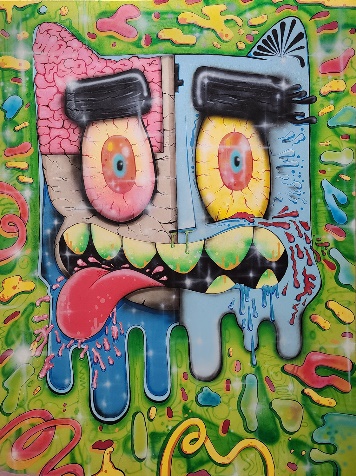
Lenny Vuitton
Anatomy of the Hooli-Gan
While the art world is ever-changing, certain art forms and subject matter have long been overlooked by the fine art community. We will embrace these underrepresented forms of artistic expression, challenging the traditional notions of “fine art.” This first-of-its-kind exhibition, The Art of Subversion, opening on Friday, September 13th, from 5-8 PM, will feature a provocative blend of tattoo-inspired art, street art, and functional glass art.
The Art of Subversion is a deliberate departure from the conventional art gallery landscape. The term ‘subversion’ is defined as “the undermining of the power and authority of an established system or institution.” With that, the exhibition is a celebration of artistic rebellion in an effort to redefine what constitutes “fine art”.
This is not simply an exhibition to showcase these various art forms. The goal is to initiate a broader conversation about how artwork is understood in our contemporary world. For decades, street art was seen as no more than vandalism, and only recently has it gained recognition for its cultural value. Similarly, while the traditional medium of tattoo art has been around for centuries, it has only been in the last few years that our society has shaken the stigma associated with the art form. The same cannot exactly be said for functional glass art, more simply known as ‘smoking pipes’… as with tattoos, the art of pipe making and the medium of glass blowing has a profound history, yet it is an outsider in the art world.
The exhibition will feature new work from some of today’s premier artists working in these genres and mediums. Notably, street artists like Chris Guest, Bloodshed, Lenny Vuitton, and Layercake bring a dynamic and rebellious spirit to the mix, while Jackee Sandelands-Strom captures tattoo art in intricate and vibrant detail, offering a fresh perspective on this marginalized art form. When it comes to functional glass art, several heavy hitters from the pipe scene will be making their art gallery debut. Two in particular are JP Toro, founder of Toro Glass, and Nate Dizzle, creator of Swiss Perc. JP is revered for both his innovation and artistic detail, while Nate Dizzle has truly pushed the boundaries of borosilicate glass-blowing.
“The Art of Subversion is more than just an exhibition; it is a revolutionary act,” says Lance Rehs. He sees this as the start of something much bigger… a shift to embracing the art of our times.
____________________
Stocks & Crypto
This pains me to say, but summer is already coming to a close… how did that happen so quickly?! Ugh, let’s not dwell on it. While August got off to a rocky start, with a sharp dip in the first few days, we’ve been on the road to a quick recovery – the Dow now sits at a fresh record, while the NASDAQ and S&P 500 are flirting with their recent records set last month. The Dow ended with about a 1.5% gain, erasing that initial 5% plunge and then some. The NASDAQ is just about even for the month, but again, we should keep in mind that it was down nearly 8% by the 5th of the month! It’s a similar story for the S&P, which is up about 2% after shedding more than 6% that first week. News coming out on the final trading day of the month suggests inflation is on par with Wall Street’s expectations, which could give enough ground for the Fed to cut rates in September… current analysis shows the markets are currently pricing in an approximate 33% chance that rates are cut by 50 basis points before the end of next month.
As for currencies and commodities… both the British Pound and Euro saw some moderate strengthening relative to the US Dollar – the Pound gained 2.3%, while the Euro gained 2.1%. Crude experienced some wild volatility through the month – every week was another story. In just a few days, it was down 6% before popping back into positive territory, then plummeting again, down more than 7.5%. Gold continues to be the real star of the show with an insane month in the midst of an insane year… gold was up more than 4% this month, bringing its year to a nearly 23% gain! Move over Bitcoin!
Speaking of… Bitcoin got absolutely smacked in August. At one point, it was down more than 25%, and it happened quickly. Just like the stock markets, by August 5th, it bottomed out… and let me point out that the month started on a Thursday, and the 5th was the next Monday, meaning in just a matter of 3 trading days, Bitcoin pricing fell off a cliff. It clawed back a chunk of that, but the premier cryptocurrency is still down more than 11% for the month. Litecoin followed suit, seeing a bit of a sell-off early on and bouncing back… it notched a similar 11% slide. Ethereum ventured off on its own course but ultimately ended in similar territory, down about 9%.
It’s hard to feel any particular way about the trading we saw this month and what it means for the future… as I always say, if anyone pretends like they know what’s going to happen next, they’re lying to you. But it’s worth keeping in mind that September is a historically down month, so temper your expectations. At the very least, maybe we can just all hope for a few more weeks of nice weather.
____________________
Really!?
Apex, The Stegosaurus Makes History
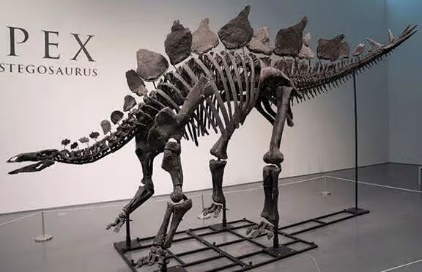
Apex
Sotheby’s recently held an auction, leaving paleontologists in disbelief and clutching their fossil brushes. The star of the show? Apex – a remarkably complete stegosaurus fossil that once roamed what is now Colorado about 150 million years ago. With its signature pointy back plates and massive rib cage, this prehistoric marvel captured the attention of bidders worldwide.
Discovered in 2022 by commercial paleontologist Jason Cooper, Apex was found on his property near the aptly named town of Dinosaur, Colorado. This tiny community, practically an amusement park for paleontologists, is near Dinosaur National Monument and the Utah border. Cooper stumbled upon a bit of femur sticking out of the ground and soon uncovered one of the most complete stegosaurus skeletons ever found; it stands 11 feet tall and stretches to 27 feet long when fully re-constructed.
The auction saw seven bidders from around the globe engaged in a fierce 15-minute bidding war. The final, mind-blowing bid was made by hedge fund billionaire Ken Griffin, founder and CEO of Citadel, who plans to loan Apex to a U.S. institution, ensuring it doesn’t end up as a quirky garden statue on someone else’s estate. “Apex was born in America and is going to stay in America!” Griffin declared, according to a source familiar with the matter. Griffin’s winning bid of $44.6 million shattered the estimated $4 million to $6 million price range and left the previous record ($31.8 million) set by a Tyrannosaurus rex fossil in the dust.
Monterey Car Week 2024

1960 Ferrari 250 GT
The Monterey Car Week 2024 brought together car collectors and enthusiasts to celebrate the art of the automobile. Renowned auction houses such as RM Sotheby’s, Gooding & Company, Broad Arrow Auctions, Mecum Auctions, and Bonhams promised a week filled with excitement, and they delivered, although not without a few surprises.
The auctions saw some fantastic sales, but the market was more cautious overall. Despite the impressive lineup of vehicles, total sales for the week were below the pre-sale estimate of $430 – 489 million, amounting to just $391.6 million, including the buyer’s premium. Buyers were very selective, especially in the high-end market where cars valued over $1 million struggled to meet expectations.
Coming in first was a 1960 Ferrari 250 GT SWB California Spider, which sold for an astonishing $17,055,000, right in the middle of the $16-18M estimate. This iconic vehicle, the first of its kind, was showcased at the 1960 Geneva Motor Show and had never been publicly available until now. The car was pristine, still painted in its original colors, and complete with the factory-equipped competition-spec engine.

1938 Alfa Romeo 8C
Second place went to a 1938 Alfa Romeo 8C 2900B Lungo Spider that fetched $14,030,000, a slight disappointment as it was expected to make closer to $20M. This Spider boasts a twin-supercharged inline-8 engine and is one of only five long-chassis models. Its rarity and impeccable condition made it one of the most sought-after cars of the week.
A 1955 Ferrari 410 Sport Spider was expected to make in excess of $15M but secured a third-place finish when it sold for $12,985,000. This one-off prototype was driven to victory by Carroll Shelby in the 1956 Palm Springs Road Races and still retains its original numbers-matching engine, adding to its historical significance.

1955 Ferrari
However, not all cars found new owners. Despite the excitement surrounding them, some of the week’s most anticipated vehicles failed to sell. It was surprising to many when a 1961 Ferrari 250 GT SWB California Spider, which had an estimate of $15-17 million, failed to meet its reserve.
Another car that didn’t find a buyer was the 1937 Bugatti Type 57SC Atalante. This rare vehicle, one of only 17 ever made, was estimated to sell for $9-11 million. The 1957 Ferrari 625 TRC Spider, a pedigreed racing machine with over 20 podium finishes, remained unsold. Estimated at $9-11 million, this car’s historical significance as a precursor to the V–12–-powered 250 Testa Rossa was not enough to secure a buyer.
Finally, the 2002 Ferrari F2001b Formula 1 car, driven by Michael Schumacher to three podium victories during his 2002 World Championship season, also failed to find a new home. Estimated to bring $8-10 million, it left many stunned when it didn’t make it to the finish line.
Ultimately, Monterey Car Week 2024 was a captivating blend of success and caution. While the event saw record-breaking sales and thrilling bidding wars, it underscored that buyers are becoming more discerning. The unsold lots, particularly those with rich histories and prestigious pedigrees, serve as a reminder that even in the world of luxury and rarity, nothing is guaranteed.
Star Wars Starfighter Flys Past Estimate

Y-wing Starfighter
model from Star Wars
The Y-wing Starfighter model from Star Wars: Episode IV—A New Hope (1977) stole the spotlight at a recent auction. This 1:24-scale miniature, a significant piece of film history, attracted considerable attention from collectors and fans.
The model’s creation began with sketches by Colin Cantwell, inspired by George Lucas’s vision. Ralph McQuarrie refined these designs, and ILM’s team, under Grant McCune’s direction, brought the model to life. Only two Y-wing models were made for the film.
This particular Y-wing, measuring an impressive 27.5 inches, was meticulously crafted from resin, styrene, acrylic, and metal, with an aluminum frame to ensure stability during filming. Its surface was intricately painted to resemble a battle-damaged spacecraft, complete with blast marks and scorchings. It was equipped with functional lighting for the engines and weapon systems and became known as the “TIE Killer” due to the TIE fighter emblem on its nose. This model took center stage during the iconic trench run sequence of the original Star Wars film.
The auction saw bids soar beyond expectations, with the model ultimately selling for an astounding $1.55 million, far surpassing the $200,000–300,000 estimate. Proving once again the lasting allure of Star Wars memorabilia and the high value placed on authentic film artifacts.
____________________
The Dark Side
The British Museum's Latest Troubles
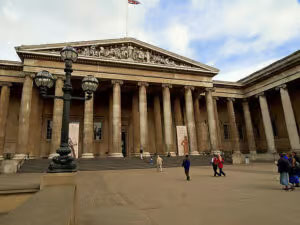
The British Museum
Last time we checked on the British Museum, they were on their way to recovering nearly half of the Higgs theft. Almost seven hundred items have been identified, located, and returned nearly a year after the theft’s initial discovery. However, this does not mean it has been all good for the museum.
In recent years, the British Museum has almost always been embroiled in controversy, ranging from restitution cases to the institution’s environmental impact. Therefore, regarding public opinion, the British Museum was already in a slightly weakened state with a decent portion of the British and worldwide population when news of the Higgs theft rocked the museum world. Recent reports show that this disapproval may now be extending to museum donations. According to Max Kendix writing for The Times, individual contributions amounted to only £7.5 million this most recent fiscal year compared to the previous year’s £25 million. Furthermore, the museum administration has now admitted that the Higgs theft may have been enabled by museum staff and leadership violating British law.
Under the Public Records Act, the British Museum is considered a “place of deposit”, used for storage by the National Archives. According to the National Archives, these places of deposit must meet certain standards regarding the care and conservation of the items in question and public access to them. The National Archives adheres to the guidelines of both the British Standards Institution and the European Standards Organizations, which both publish guidelines on “the location, construction and arrangement of building specifically intended for internal storage of all heritage collection types and formats.” The museum’s most recent annual report states that the British Museum is not compliant with these standards following an internal audit. Museum chairman George Osborne said they are “continuing to work with the National Archives towards compliance”. The museum plans on achieving this by “scrutinising areas of perceived higher risk” and “concentrating on implementing agreed changes recommended by the Independent Review. These changes relate to collection management, security procedures and processes and governance.”
The Higgs theft exposed the many gaps and flaws in the British Museum’s security, which its leadership has either negligently allowed or even maliciously encouraged over the years. As a place of deposit under the Public Records Act, the British Museum can have a good chunk of its collection transferred to a different location. However, many commentators have deemed this unlikely. In the wake of the theft, the museum is working to completely digitize its entire collection, all eight million items, to prevent a theft like the one Higgs allegedly perpetrated from happening again. It’s sad that in such a trove of the world’s culture, heritage, and knowledge, it took the loss, damage, and destruction of thousands of items for substantial change to be realized.
Lawsuit Against AI Companies Continues

AI
In a victory for artists against tech companies, a federal court has allowed a lawsuit against a group of companies to continue, ruling that their art-generating artificial intelligence programs may violate artists’ rights.
The last I wrote about this particular case was in November 2023, when Judge William Orrick, a senior judge for the district court for the Northern District of California, allowed a group of artists to amend and refile their lawsuit against a handful of tech companies, including Midjourney, Stability AI, and Deviant Art. Of the artists named as plaintiffs in the suit, only Sarah Anderson has her copyrighted works registered with the US Copyright Office. Orrick dismissed all but Anderson’s claims, given this information. Since then, seven more artists have joined the suit. Last week, Orrick threw out the claims of unjust enrichment, breach of contract, and violations of the Digital Millennium Copyright Art. Yet, he allowed the claims of trademark and copyright infringement to continue.
The court also rejected the companies’ claims that the artists had to name specific artworks used to develop the AI programs. The defendant companies all trained their AI programs using data sets from LAION, comprising five billion images collected from internet sources. Orrick wrote, “Given the unique facts of this case — including the size of the LAION datasets and the nature of defendants’ products, including the added allegations disputing the transparency of the ‘open source’ software at the heart of Stable Diffusion — that level of detail is not required for plaintiffs to state their claims”. The artists demonstrated that these programs could generate a work replicating an artist’s style simply by entering their name as a prompt. Orrick, therefore, wrote in last week’s ruling that the allegations that the AI programs were “created to facilitate [copyright] infringement by design” were sufficient for the suit to continue. But Orrick did not address the main issue at the heart of the case, whether or not the companies’ use of existing art to train their AIs’ art generation capabilities constitutes copyright infringement. While this is not the end of this dispute, it is a significant step forward for the artists. Lawyers for the defendant companies claim that if the suit is successful, it would allow any artist to sue any company that used their programs. “The havoc that would be wreaked by allowing this to proceed against DeviantArt is hard to state”.
Shady Shakeup From Slovak Culture Minister

The Slovak National Gallery,
at the Esterházy Palace
(photo courtesy of Ľubomír Repta)
Over the past month, the Slovak art world has been rocked by disputes between its cultural sector and political leadership.
On August 7th, the cultural minister Martina Šimkovičová dismissed the director of the Slovak National Gallery, Alexandra Kusá. Many see Kusá’s dismissal as part of a purge of Slovakia’s cultural institutions. Other cultural leaders without jobs include the now-former directors of the National Theater, the National Library, and the Bibiana children’s museum in Bratislava. The cultural ministry has given vague or insufficient justifications for the firings if it provided any reason at all. The most recent development in this ongoing saga is that the National Opera’s director, Martin Leginus, has tendered his resignation after parliament failed to oust Šimkovičová after two no-confidence votes. These votes occurred during a special session, so the opposition parties’ efforts must continue when parliament reconvenes in September.
Many expected changes to the cultural sector with Šimkovičová’s appointment in October 2023. While Prime Minister Roberto Fico has been described as a populist leftist, Šimkovičová’s appointment results from his party’s coalition with the conservative Slovak National Party. Šimkovičová’s statements as a member of parliament from 2016 to 2020 and now as cultural minister have been described as nationalist, racist, homophobic, xenophobic, and anti-Semitic. In 2018, Slovakia’s Human Rights Institute named her “homophobe of the year”. Now-former National Theater director Matej Drlička stated that Šimkovičová’s first statement as cultural minister seemed “like a fascist declaration” and that her appointment was when he realized “we were entering a new culture war.” Her conduct as cultural minister has drawn comparisons to Hungarian prime minister Viktor Orbán’s recent crackdowns on media and cultural institutions.
On August 12th and 13th, thousands filled the streets of Bratislava to protest these purges. On the first day of the demonstrations, over three hundred artists and cultural sector employees from across Europe signed an open letter opposing these dismissals. Since then, another one hundred fifty have added their names. The signatories include the directors and curators of Amsterdam’s Stedelijk Museum, Barcelona’s Museum of Contemporary Art, Madrid’s Reina Sofía Museum, Warsaw’s Museum of Modern Art, Zagreb’s Museum of Contemporary Art. The letter states that Kusá’s dismissal “undermined the independence of the cultural field” and “damaged the trust in and reputation of Slovak culture internationally.” The signatories further wrote, “We ask you to reject the direct political control of cultural institutions and defend the right of art and artists to freedom of expression.” On top of the open letter, a petition has circulated to reverse the dismissals, collecting over 180,000 signatures. The National Gallery’s staff has issued a statement in support of its former director, writing that the museum “stands firmly behind Alexandra Kusá, recognizing the immense effort, time, expertise, humanity, innovative vision, and at times, superhuman dedication she has invested in building a national cultural institution that truly understands the real meaning and value of the words ‘national,’ ‘culture,’ and ‘institution.’” Six former Slovak culture ministers have also spoken out against Šimkovičová.
Commentators have expressed confidence in the resistance from Slovakian protestors and cultural figures worldwide. They also seem to think little of the nationalists who support these changes. Drlička has stated, “They haven’t proposed an alternative vision. To say that these people have a grand vision for Slovak culture would be to seriously overestimate them.”
____________________
The Art Market
One of the best things about August is the lull it brings to the art market, especially at the major auction houses and galleries worldwide. This quiet period offers a much-needed break for those of us in the industry, allowing time to recharge and get ready for the action that will kick off again in September.
____________________
Deeper Thoughts
Digital Warhol Portrait Rediscovered

Andy Warhol
A long-lost digital portrait by Andy Warhol has recently resurfaced after nearly forty years.
Digital art has been a popular topic for critics and commentators within the art world for several years now. This is mostly because of the rise of AI and NFTs and what they mean for both the art market and the livelihood of artists themselves. However, digital art is a far older medium than some people like to think. In 1985, personal computers were starting to become a major consumer item. That year, to show off their Amiga 1000 computer, the tech company Commodore organized an event with Andy Warhol and Blondie lead singer Debbie Harry. Using the computer, Warhol created a completely digital portrait of Harry at an event at Lincoln Center.
Warhol was already somewhat familiar with digital art at the time. In his biography of Steve Jobs, Walter Isaacson relates a story of the tech giant attending Sean Lennon’s ninth birthday party in October 1984. Another attendee was Warhol, who took an interest in the Apple Macintosh computer Jobs had brought with him. Excited at experimenting with the new medium’s drawing application, Warhol reportedly shouted at Keith Haring, “Look! Keith! I drew a circle!” In her 2019 book, Debbie Harry explained that they printed only two physical copies of the image, one of which was given to her. The whereabouts of the other were previously unknown. That is until computer technician Jeff Bruette claimed to own the second copy. Brunette is the Commodore technician who taught Warhol how to operate the Amiga 1000. According to Bruette, Warhol gave him the other printed copy as a gift. Bruette not only has the other physical copy of the Debbie Harry portrait, but also a Warhol-signed disc containing its file and several other images Warhol made using the computer. Warhol created some of these images while sitting for an interview for Commodore’s magazine Amiga World. We only know this because Bruette announced his plans to sell the image and the disc. “I thought it was time the world got to interact with this extraordinary artwork the way it was meant to be experienced.”
Some have estimated the image to be worth millions, with Bruette giving an asking price of $26 million. In 2021, five NFTs made from some of Warhol’s drawings using the Amgia were sold at Christie’s for $3.4 million. Though Bruette has received several offers from galleries and auction houses, he plans to sell the work privately.
Renaissance Drawing From The Royal Collection

The Three Graces by Raphael
Works on paper by Renaissance masters from the British royal collection will soon be displayed in a new exhibition at the King’s Gallery.
The King’s Gallery at Buckingham Palace is a public museum dedicated to showcasing selections from the British Royal Collection, one of the largest private collections in the world. The collection’s contents range from Old Master works to twentieth-century acquisitions. These include Vermeer’s Music Lesson, Titian’s Bacchus & Ariadne, Warhol’s Queen Elizabeth prints, and countless royal portraits from various European painters. The museum was originally opened as the Queen’s Gallery in 1962, using Buckingham Palace’s south wing. Recently, the palace announced that it is planning an exhibition of works on paper, some of which have never been exhibited in Britain.
The upcoming exhibition, Drawing the Italian Renaissance, will open on November 1st. It will feature nearly one hundred sixty pieces by eighty-one artists, mostly between 1450 and 1600. Twelve of these works have never been exhibited in Britain before, while thirty have never been publicly displayed at all. It is likely Britain’s most comprehensive exhibition of Renaissance drawings ever organized. Some of the exhibition’s highlights will include Raphael’s red chalk drawing The Three Graces, the metalpoint portrait Bust of a Cleric attributed to Fra Angelico, and a study of an ostrich by Titian. According to the gallery curator Martin Clayton, “These drawings cannot be on permanent display for conservation reasons, so the exhibition is a unique opportunity to see such a wide range of drawings up close and gain an insight into the minds of these great Italian Renaissance artists.” The exhibition is an opportunity to show some of the royal collection’s drawings and prints from the Renaissance period and to emphasize some of these artists’ abilities at working with such media. For example, Clayton highlights artists such as Parmigianino and Andrea Sonsovino, known primarily as a painter and a sculptor, respectively. Therefore, Parmigianino’s preparatory drawings and Sonsovino’s designs and studies in the royal collection show their skills as draftsmen. It highlights the art of drawing as a respected medium in its own right and an absolutely necessary part of many other artistic media. As part of the exhibition, three artists-in-residence from the Royal Drawing School will be drawing in the gallery spaces three days per week while the exhibition is open. The King’s Gallery will also make drawing supplies available to visiting members of the public.
Drawing the Italian Renaissance will run from November 1, 2024 to March 9, 2025 at the King’s Gallery, Buckingham Palace.
Banksy's Latest Guerrilla Art Campaign

Banksy
Banksy has been let loose on London this week, unveiling a new work every day.
On Monday, August 5th, a graffiti silhouette of a goat appeared on the side of a building near the south bank of the Thames in Richmond. Banksy’s Instagram page posted an image of the work with no caption, leaving many to speculate on its meaning. One of the most popular interpretations is that the goat carefully standing on a cliff as small rocks fall off the edge represents Britain’s precarious position as riots by far-right demonstrators have rocked the country recently. Others say that the goat represents humanity at the edge of a precipice, pushed by conflict, political turmoil, and climate change. Interviews with locals indicate that they are pleased with the silhouette, a sentiment shared by many who have seen the work. It was the first graffiti work by Banksy since March when a mural in the north London neighborhood of Finsbury Park was unveiled and later covered up.
The following day, Banksy struck again, this time with another unexpected animal silhouette. The image of two elephants reaching across and joining trunks from a pair of blocked-out windows was a surprise to the people of Chelsea. Then, on Wednesday, more animals appeared, this time on the east side of London. On a bridge over Brick Lane, a trio of monkeys appeared. Like the goat, the elephants and monkeys appeared on the artist’s Instagram page without any caption, title, or explanation. Despite my initial expectations, the monkeys on the bridge are not covering their respective eyes, ears, and mouth. They appear rather naturalistic, swinging and brachiating from a crease in the concrete.
Things seemed to go smoothly until Thursday when Banksy’s fourth animal got into trouble. A howling wolf stenciled in the middle of a fake satellite dish appeared on the roof of a building in Peckham in southeast London. By this point, commenters have begun to call the project Banksy’s London Zoo series. The wolf breaks the pattern that seems to be emerging or adding one more figure to each group. With one goat, two elephants, and three monkeys, many anticipated four wolves instead of just one. However, not long after the wolf was unveiled, reports came in that the dish, which seems to have been purpose-built and erected for the work, had been removed from the roof. BBC News published a video showing a trio of men taking the dish and running away.
Anticipation was high for Banksy’s next move as Friday dawned. Many predicted another work to be revealed on Friday. However, some, like Arts University Bournemouth vice-chancellor Paul Gough, expected a larger, grander finale to this series. In the end, Banksy presented us with another animal silhouette: a pair of pelicans appropriately perched on the sign of a fish-and-chip shop in the north London borough of Walthamstow. One of the pelicans is stenciled bending down to snatch up one of the fish on the shop’s sign. No one is certain about the message behind the series if there is one at all. In the past, Banksy has often imbued his work with political and social commentary, hence the search for deeper meaning in these animals. It’s also not certain whether the series stops here. Though the week is over, there may be more animals appearing throughout London in the near future.
Banksy's London Zoo Completed
Last week, London became populated with stenciled animal silhouettes credited to the anonymous street artist Banksy. I initially thought he would stop on Friday with his duo of pelicans on the sign of a fish-and-chip takeaway. However, he continued over the weekend, finally stopping on Tuesday, August 13th.

Banksy’s goat near
Kew Bridge, Richmond
(photo courtesy of Jim Linwood)
Many were surprised on Saturday morning to find a large, black cat stretching across an empty billboard on the Edgware Road in Cricklewood. But after only a few hours, reports came in that the cat, like the wolf, had also been removed. But unlike the incident with the wolf, it seems no one stole the cat. A contracting company claims to have removed it to prevent it from being stolen or defaced. Some of the animals have met this fate, prompting the first in the London Zoo series, the goat near Kew Bridge in Richmond, to have a plexiglass panel placed over it. While the contractors removed the cat from the billboard, onlookers expressed their disapproval of the decision. The billboard’s owner, however, has commented that they plan on donating the cat to a gallery. Michel Boersma, a curator who has worked closely with Banksy, also spoke out against this move: “These street artworks need to be seen on their original locations, as intended by the artist.”
Starting on Sunday, though, Banksy’s animals became more than silhouettes. That day, Banksy painted a glass police sentry box to look like a fish tank full of piranhas in the City of London. The fish, however, were more than just black shapes. The box included blue, with gray and white detailing to show exactly what kind of animal this is. After the artist posted an image on his Instagram page, the box was quickly moved from its original location near the Old Bailey to a better location by London’s Guildhall, as it is more suitable for large groups of people who may want to visit the box. Authorities blocked off the sentry box with barricades to prevent it from being defaced or damaged. The next installation in the series was found on Monday in Charlton, in southeast London, consisting of a rhinoceros in a rather racy position in relation to an abandoned car. One commenter on Instagram wrote, “To be fair the Rhinos are running out of mating partners.” Like the fish the previous day, the rhino was not just a simple black silhouette. Banksy painted the animal in its natural gray with detailing in black. It didn’t take long, though, for the car to be removed and for another graffiti artist to tag the rhino.
It seems those who called this series Banksy’s London Zoo were onto something. The last day of the series consisted of a final stenciled work at the gates of London Zoo in Regent’s Park. This was the only work in the series with more than one type of animal. A gorilla with some detail in the face rather than just a silhouette is lifting the roll-up security gate at the zoo’s entrance to let out the animals. These include a sea lion, a variety of birds, and unseen animals whose eyes stare out from the darkness under the gate. With this final piece, Banksy tells a lighthearted story of animals escaping from the zoo and being found all over London. The zoo announced it is making arrangements to preserve the work. But there’s also a different message in the London Zoo series. Banksy is known for his thought-provoking work imbued with political or social commentary. For the entire duration of the London Zoo series, both art world specialists and the general public speculated as to the meaning behind each of the individual entries in the animal silhouettes. But Banksy’s agency, Pest Control, stated that “recent theorizing about the deeper significance of each new image has been way too involved”. I think the greater message is that although art can be used to convey profound messages, it is sometimes just as useful when it’s just for a bit of fun.
Orientalism: Harmless Or Problematic?
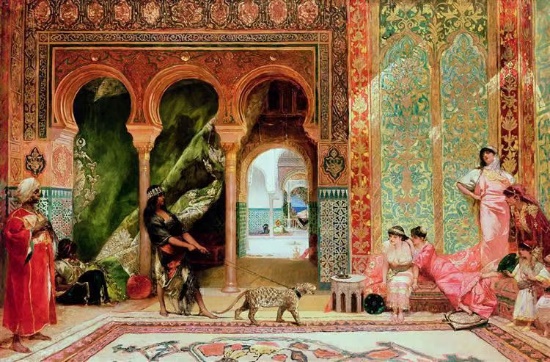
A Royal Palace in Morocco
by Jean-Joseph Benjamin-Constant
In 2020, the British Museum hosted an exhibition called Inspired by the East, delving into how the Islamic world made its way into Western art. Writing for Hyperallergic, Aditya Iyer described the exhibition as a “worthwhile but flawed” attempt to “extract Orientalist art from its sinister role in fostering Western perceptions and depictions of the East”. While Iyer admits that the paintings and artifacts in the exhibition are beautiful, the British Museum failed to fully acknowledge the art’s complex history. The exhibition recognized that many see Orientalism as problematic, but it failed to address why that is. They thought that the paintings could speak for themselves. But why is Orientalism considered problematic? Is it okay to like it? And, if so, when is it alright?
According to Oxford Languages, Orientalism is “the representation of Asia, especially the Middle East, in a stereotyped way that is regarded as embodying a colonialist attitude.” Note how the dictionary definition, right up front, acknowledges the negative connotations attached to the word. Orientalism has been with us for centuries, stretching from Old Master paintings to Disney films like Aladdin. And even though it’s often easy to hide behind excuses like, “It’s just a painting,” the purpose behind a work’s creation and the context in which it was made and exhibited is just as important as its subject. The genre of Orientalist art sometimes twisted, exaggerated, and fetishized the people, culture, and places of the Middle East and North Africa, reinforcing stereotypes about the region that justified the colonial endeavors of European empires.

The Snake Charmer
by Jean-Léon Gérôme
In the nineteenth century, Orientalist art was popular in Europe because of two converging factors: exoticization and colonialism. Exoticization is the natural human interest in the other or the unknown. Even though locations like Algiers and Cairo were just across the Mediterranean from Western Europe, the differences in climate, culture, language, and religion made the Middle East and North Africa seem so distant. These differences were so great that the region could be used almost as a backdrop for pure fantasy. In wanting to provide a certain aesthetic, many Orientalist artists would often draw not from travelogues or the writings of anthropologists, but their own imaginations. The best example is Jean-Léon Gérôme’s The Snake Charmer, which mainly uses meaningless scribbles as a stand-in for Arabic calligraphy on the wall. This is not unique to The Snake Charmer and is a phenomenon in Orientalist art that Nesrine Malik described as “pseudo Arabic that used the script to lend authenticity, but is in fact a clumsy imitation of loops and lines that are unintelligible.” But this is just one of the painting’s many eyebrow-raising characteristics. “The East” in these artists’ minds was wild, mystical, and brutal compared to the cultured, educated, proper “civilization” they came from. In The Snake Charmer, we see a boy displaying a snake to entertain a group of men. The boy is completely naked, with a lack of clothing hinting at the region’s perceived licentiousness. The men are all reclining on the floor, backs against the wall, conveying a sense of idleness. But very importantly, the painting has an aura of mystery, a key component of Orientalism. The art historian Linda Nochlin writes that through The Snake Charmer, Gérôme provides “an unrealistic scene as if it were a true representation of the east.”
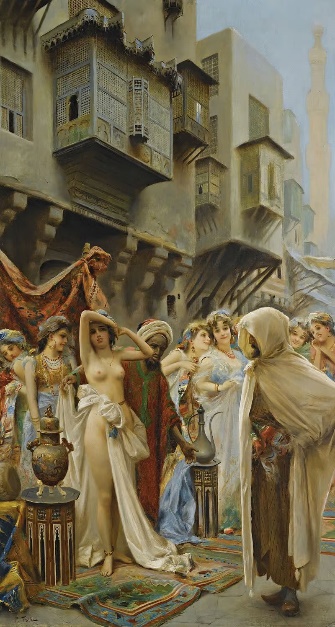
The Slave Market
by Fabio Fabbi
The setting of the East gave European artists liberties they would not have otherwise enjoyed. For decades, Orientalist painting was the only artistic genre where overt sexuality of any kind was permissible. Of course, nudes were commonplace in European academic art, but not in the same way as in Orientalist paintings. In academic art, nudes were reserved for mythological subjects and allegorical figures. But in Orientalism, painters depicted women of any kind in an inherently sexual way that would have been scandalous if applied to a woman of the artists’ own countries. The sexualization of Middle Eastern and North African women stems partly from European perceptions of the Ottoman upper classes and their practice of keeping harems. The harem was simply the women’s quarters of the household, but in the European imagination, men always used it to keep their flock of wives and concubines. It reached the point that any Orientalist-inspired nude painting bore the title odalisque, the French approximation of the Turkish word for a chambermaid, odalık. An odalık employed in an Ottoman household was not a concubine, yet they were perceived this way in Europe, particularly in France. The sexualization of the region’s people gave rise to the odalisque genre of nude figure painting, which only reinforced further sexualization. Art historian Nicholas Tromans wrote that the odalisque was meant to be “offered up to the viewer as freely as she herself supposedly was to her master”. Nineteenth-century painters like Jean-Auguste-Dominique Ingres, Eugène Delacroix, Jean-Léon Gérôme, and Frederick Arthur Bridgman all indulged this urge. The region’s perceived barbarity collided with this sexualization through Orientalist art’s fixation on slavery. By the mid-nineteenth century, most European states had outlawed slavery, with treaties and alliances formed to prevent the slave trade. At the same time, the nude enslaved woman became a popular subject among European Orientalist painters like Otto Pliny, Fabio Fabbi, and Giulio Rosati. Gérôme was probably the most prolific painter of Orientalist slave scenes, namely slave markets. Combining sex and savagery, these paintings’ female subjects are always completely passive, with no other role than being the focus of the male gaze.
Depictions of men in Orientalist paintings are a little more complicated as they come in one of two main varieties: the warlike and the devout. Men are either shown as heavily armed regardless of their situation, or in a mosque setting, normally on their prayer mat. Writing for The Guardian, cultural critic Nesrine Malik acknowledges that this is one of the interesting aspects of the genre that the British Museum tried to highlight in its 2020 exhibition. Alongside a lot of the racist clichés, Orientalist paintings also showed how Europeans perceived Islam as a religion. It often ranged from fascination to admiration. The piety shown in paintings like The Prayer by Frederick Arthur Bridgman was something admirable, and how shameful it is that Western perceptions of Islam have changed so much in a radically different direction, one associated with extremism and violence. Malik wrote, “If the orientalism of the past was patronising fetishisation, it is still a far more respectful perspective than the fearful one that predominates today.” However, since Europeans saw the Middle East and North Africa as inherently mystical yet wild and uncivilized, these forms of exoticization led to the other main reason Orientalism remained popular in the nineteenth century: colonialism.
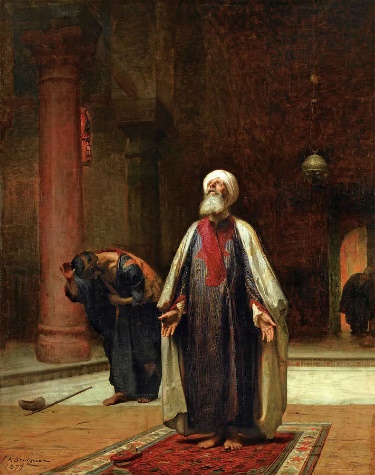
The Prayer
by Frederick Arthur Bridgman
With advances in communication and transportation technology, the nineteenth-century world grew more interconnected with each passing year. Parts of the globe that seemed far-flung were more readily accessible for Westerners because European nations began exerting direct control in these areas. France seized control over Algeria in 1830, holding onto it for over one hundred thirty years. Though nominally part of the Ottoman Empire, Egypt was a British protectorate from 1882 until the Suez Crisis in 1956. Even into the twentieth century, European colonial powers jockeyed for control of the region, with the 1916 Sykes-Picot Agreement laying out how Britain and France carved up the Ottoman Empire after its defeat in the First World War. This colonial context significantly influenced the creation and reception of Orientalism. This art, in turn, came to shape Western perceptions of the East.
It is very important, however, to distinguish between this problematic context and problematic subjects. All Orientalist paintings have associations of colonialism attached to them. Eastern subjects would not have become popular had it not been for French and British colonization bringing these locales into the public imagination. But as long as we recognize the problematic context, we can still enjoy a painting as long as the subject does not reflect racist stereotypes. It’s easy to say that nearly everyone was racist in the nineteenth century, but that clearly isn’t as true as it seems. Many Western painters approached Eastern subjects without resorting to such offensive generalizations, creating works we can still enjoy today. John Frederick Lewis, for example, did what not many of his Orientalist contemporaries did and moved to the region. While Delacroix and Ingres created their odalisques without ever visiting Egypt or Algeria, Lewis lived in Cairo for nearly ten years, making detailed genre scenes and interiors showing episodes from daily life. Lewis refrained from applying a layer of sexualization to his female subjects, using his wife as a model to show scenes of Egyptian women preparing and serving coffee or spending leisure time in the garden. Lewis and some other painters depicted the household women’s quarters closer to how they actually operated: less a place of concubines and more “a place of almost English domesticity,” according to Tromans. Even art historian Philippe Jullian admits that among the bare-breasted harem slaves other Orientalists preferred, the women in Lewis’s paintings stand out: “But only a perverse mind would be suspicious about the delightful Egyptian women, painted by Lewis”. As an English painter depicting Eastern subjects, Lewis still indulged the Western demand for exotic subjects. But at least he and others show that these paintings do not need to employ such heavy-handed clichés. His work later inspired like-minded Orientalist painters like Edward Lear, who focused mainly on landscapes and architecture rather than sensationalized scenes of savageness and sex. Lewis’s French contemporary, Charles-Théodore Frère, also created wonderful Orientalist landscapes, gaining fame for capturing the light over the Nile at different times of the day.
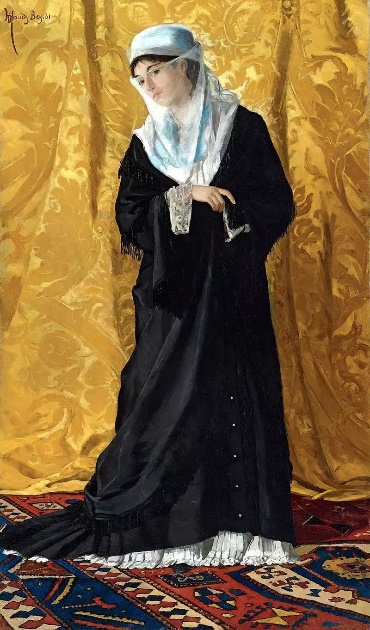
A Lady of Constantinople
by Osman Hamdi Bey
But even in this relatively inoffensive variety of Orientalism, we still must contend with some problematic aspects. Again, colonialism was one of the major reasons why even these landscapes and genre scenes had a market in Europe. But it also presents the problem of agency. By capturing the look and feel of the Islamic world from Morocco to Turkey, European artists were doing something they believed the region’s people were incapable of doing themselves. In the same way that the racist stereotypes reinforced European notions that Middle Eastern and North African people could not effectively rule themselves, these artists took agency away from the region’s people to represent themselves artistically. Of course, it’s not that Islamic artists could not represent themselves; they simply chose not to. With exceptions like Iran, much of Islamic art follows the rule of aniconism, refraining from depicting human figures. Instead, most Islamic art focuses on calligraphy, geometric patterns, and natural motifs. Architecture was also one of the main art forms, so beautiful that even the reconquering Catholic armies in Spain could not fully bring themselves to tear the buildings down. That is why structures like the Great Mosque of Córdoba, the Alhambra, and the Alcázar of Seville still stand today. So, scenes from history and daily life were not normally a priority for artists in the Middle East and North Africa.
But luckily, some Eastern artists recognized that Orientalist art was often rife with misconceptions and clichés. Several of these Eastern artists fought back in their own way. Among the best-known of these artists is the Ottoman painter Osman Hamdi Bey, who studied art in Paris under Gérôme. He mastered European painting techniques to create authentic snapshots of life in Turkey. He depicted his female subjects without any added exoticization or sexualization. The women in his paintings wear traditional clothing as opposed to the scantily clad dancers and concubines of Otto Pliny, Edwin Long, and Théodore Chasseriau. Also, they are not all simply lounging about in a harem or a bathhouse. Rather, they read, socialize in public, gather flowers, and perform other tasks. Hamdi even created paintings showing Western tourists in an Eastern setting, like in The Persian Carpet Dealers. Furthermore, the men are not savages, constantly bearing rifles and scimitars, but they are not always in a mosque setting either. They are scholars and enjoy leisure activities like chess. His paintings also often have deeper messages, serving as social commentary. Arguably, his most famous painting is The Tortoise Trainer, showing an older man in traditional Ottoman dress trying to control a group of tortoises, who ignore him and prefer to focus on the leaves on the floor. Many interpret the painting as a metaphor for the difficulties of implementing social and political reform in the Ottoman Empire. Hamdi’s 1903 painting Keeper of the Mausoleum has another hidden message. The work shows a man, again in traditional Ottoman dress, standing guard over a tomb containing a pair of children’s sarcophagi. Some interpret the painting as another metaphor representing the desire to preserve and maintain Ottoman cultural heritage. Hamdi’s paintings were not just well-executed scenes of Ottoman life but a concerted effort to combat some of the more hurtful stereotypes present in some European Orientalism. Sotheby’s nineteenth-century specialist Harry Edmonds described Hamdi’s work as “aesthetic constructions designed to attract the attention of a Western public by combining clichés intelligently with the privilege of being an ‘insider within the outside.’”
To many, the context in which European artists made Orientalist paintings is incredibly uncomfortable. The question then becomes, do we fully recognize the racism and the troublesome context of even the most inoffensive Orientalist painting? Or do we brush it under the rug for the sake of enjoying a painting, or make it more appealing to buyers? No one is saying that Orientalism should be entirely rejected or wholly accepted without any caveats or conditions. There’s nuance to this conversation, which unfortunately requires extra effort that some are unwilling to put in. I think it’s a balancing act. The problematic qualities of some paintings are insufficient to outweigh their aesthetics or artistic merit. However, there are others where it is the opposite, and our modern sensibilities keep us from enjoying particular paintings regardless of the artist’s skill. With the world now more interconnected than ever, it becomes increasingly important to have these conversations. These paintings teach us valuable lessons about cross-cultural exchange, art’s impact on geopolitics, and how choices made centuries ago can still influence our modern perceptions of people and places. While one’s stance in this debate is their own, the important thing is having this debate in the first place.
Reunited Rembrandt Portraits

The separated Rembrandt portraits
The Nivaagaard Collection, a short drive north of Copenhagen, has previously reunited paintings that were formerly displayed together. And they are doing it again, this time with a pair of Rembrandt portraits.
In March 2023, I wrote about the Nivaagaard Collection and how it facilitated a different reunion. The museum is known mainly for its collection of northern European Renaissance and Baroque paintings, including those by Lucas Cranach the Elder, Pieter Brueghel the Younger, and Pieter Claesz. The 2023 reunion concerned a family portrait by Cornelis de Vos, which had been broken up and separated in the nineteenth century. The Nivaagaard already had one-half of the painting in its collection. With help from the Netherlands Institute for Art History, the Nivaagaard Collection reached out to a private collector to help reunite their half with the painting’s other piece. In this most recent case, the reunited paintings are not part of the same canvas but have always been two separate works meant to be displayed as companion pieces. This, however, has not been the case in over two centuries.
Dating to 1632, the pair of Rembrandt portraits, likely of a husband and wife, have been separated since 1801 after they were sold in Paris. The woman is part of the Nivaagaard permanent collection, while the man has been in the Metropolitan Museum of Art in New York since 1964. The Metropolitan Museum has agreed to lend their painting to the Nivaagaard, not only so the two Rembrandts can be displayed together again after 223 years, but so scholars and specialists can run scientific tests on the works together. There have long been doubts about whether or not the two are, in fact, companion pieces. These studies should answer some of these long-standing questions. The day before the planned exhibition opens to the public, the Nivaagaard Collection will host an event for a select group of art historians and technical experts from several European and American museums and research bodies, including the Nivaagaard, the Metropolitan Museum, the Rijksmuseum, the National Gallery of Denmark, the Netherlands Institute for Art History, Dendro.dk, and Art +Image.
The Rembrandt Reunited exhibition will run at the Nivaagaard Collection from September 3rd to November 10th.
Lisbon's "Revolutionary" Graffiti Project
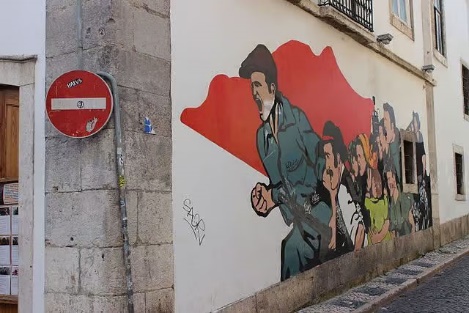
A mural by António Alves and RIGO in Lisbon
(photo courtesy of Metro Centric)
The city of Lisbon is commissioning graffiti artists to create new work around the city to commemorate the anniversary of Portugal’s transition to democracy.
Lisbon’s municipal council is seeking to commemorate the fiftieth anniversary of Portugal’s Carnation Revolution, which initiated the country’s transition to democracy after decades of dictatorship. From 1926 to 1974, an autocratic government ruled Portugal. Between 1933 and 1968, the dictatorial prime minister António de Oliveira Salazar led the country. With Salazar’s death in 1968, the government began to weaken, prompting the military to launch a coup on April 25, 1974. With the coup underway, spontaneous popular demonstrations broke out in Lisbon in support of the rebellion. Thousands gathered in the city’s flower market, where carnations were abundant as they were in season. Demonstrators began wearing the carnations on their clothing, while soldiers put the flowers in the barrels of their guns.
Portugal’s transition from dictatorship to democracy is inherently linked with street art. Street art often plays an important role in areas affected by conflict or political turmoil. Northern Ireland, for example, is dotted with murals and graffiti reflecting the many aspects of the sectarian conflict that rocked the country from the 1960s to the 1990s. After the downfall of Portugal’s dictatorship, the country’s streets became colored with murals, slogans, caricatures, and other forms of expression. Much of it was political. Some political parties were well-funded and could print posters and distribute leaflets. Others, particularly leftist parties, had no such funds and turned to street art to disseminate their messages.
Therefore, the municipal council and Lisbon’s Gallery of Urban Art have posed the question, “Where is freedom?” as a prompt for a group of street artists. Representing five decades since the Revolution, five artists will create five original works around the city as an answer. The artists include António Alves, Ines Arisca, Kruella d’Enfer, MaisMenos, and Youth One. Alves is an older street artist, having originally gotten his start in the years leading up to the Carnation Revolution. He initially practiced street art as a form of civil resistance and continues to draw from that tradition by pulling from the aesthetics of Maoist social realist painting. Adalberto Brito, who popularly goes by the name Youth One, has been creating street art since he was a teenager in the late 1980s when graffiti and street art became a recognized art form in Portugal after decades of repression. The progression of YouthOne’s work in Lisbon’s Liberdade neighborhood bordering Monsanto Park is being documented by the artist on his Instagram page. In contrast, Arisca and d’Enfer are relative newcomers to the genre, but their inclusion promises to bring newer, more feminine perspectives on the subject matter.
By inviting a diverse group of artists to offer their take on the same subject, the project helps younger generations with the Carnation Revolution’s continuing legacy. It helps connect people with important historical moments in new and interesting ways. The new, completed murals will be unveiled on September 10th.
Smelly: Upcoming Exhibition Highlights Scent In Art
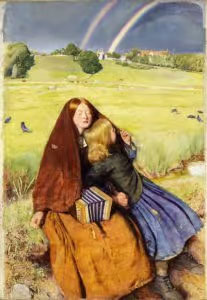
The Blind Girl
by John Everett Millais
In my deep dive into the connections between counterculture and Pre-Raphaelite painting, I partially focused on the use of natural motifs in both movements, namely flowers. With such an emphasis on floral elements, one British museum is staging an exhibition of Pre-Raphaelite works but looking at things from an unusual perspective. The exhibition highlights one of the senses rarely used in the traditional fine arts: scent and smell.
Starting on October 11th, Birmingham University’s Barber Institute of Fine Art will put on an exhibition called Scent & the Art of the Pre-Raphaelites. The show will explore the aromas evoked by the paintings and discuss how the Victorians perceived scent and smell. The exhibited paintings will include The Blind Girl by John Everett Millais and A Saint of the Eastern Church by Simeon Solomon, as well as works by Rossetti and Waterhouse on loan from the Ashmolean Museum and the Tate Britain. I initially thought the museum might pump the scents into the galleries where certain paintings are displayed. However, the Barber has gone for a different approach since that route may damage the pigments or canvas of the exhibited works. They plan on having small diffusers near the paintings, which individual museum-goers can approach and press a button to release the aroma. Smells of grass and flowers in a meadow following the rain will accompany the Millais. Meanwhile, aged wood and the aromatic oils from an incense burner would be the better choice for Solomon’s saint.
Olfactory technology is not new to museums. In 2022, Madrid’s Prado Museum enlisted the help of the Spanish perfume company Puig to develop a scent comprised of ten flowers, plants, and other elements from a large painting by Jan Brueghel the Elder. These included daffodils, iris, jasmine, orange blossom, rose, and the musk of a civet, the animal curled up near the nude female figure on the right side of the work. Several diffusers sat in the same room as the painting, where visitors would approach and interact with a touchscreen to experience just a small handful of the over eighty plant and flower species identified in the Brueghel painting. The aroma element of the display resulted in gallery visitors spending far longer viewing and interacting with the painting. Compared to the average of thirty-two seconds that a Prado visitor might spend looking at the Brueghel, adding the aroma diffusers increased that average to an incredible thirteen minutes.
The Barber Institute is also collaborating with Puig for its Scent & the Art of the Pre-Raphaelites exhibition, which will run from October 11th to January 26th.
Demotion in Dresden: Friedrich Landscape Loses Attribution

Landscape with a Bare Tree,
previously attributed to
Caspar David Freidrich
Caspar David Friedrich, a celebrated figure of Romantic painting in Germany, is currently under the spotlight. A painting featured in an exhibition dedicated to his work has unexpectedly lost its attribution to the artist.
Like his British contemporary J.M.W. Turner, Caspar David Friedrich was most impactful in landscape painting. Specifically, he became known for emphasizing humanity’s contemplation of nature through works like Wanderer Above the Sea of Fog, The Abbey in the Oakwood, and The Monk by the Sea. They convey messages about the natural world’s enormity and its ability to withstand and overcome the chaos and destruction that might wreck human civilization. Several cultural institutions worldwide are preparing special events and exhibitions for his 250th birthday (on September 5th of this year). For example, the Metropolitan Museum of Art in New York will stage the first museum exhibition in the United States solely dedicated to Freidrich starting on February 8, 2025. The Dresden State Art Collection recently opened its own exhibition dedicated to the artist on August 24th, featuring highlights from the collection’s trove of Friedrich works. Entitled Friedrich: Where It All Started, the exhibition at the Albertinum’s Galerie Neue Meister displays the artist’s work and that of his colleagues and contemporaries alongside their Old Master predecessors like Lorrain and Ruisdael. One of the core goals of the exhibition is to dispel the longstanding myth that Friedrich was a misanthropic loner who created his oeuvre in relative isolation from Dresden’s artistic community. He had a widespread network of friends, acquaintances, and students, especially among the Central European Romantics like Carl Gustav Carus, Johan Christian Dahl, and Carl Robert Kummer. In the middle of it all, though, one painting on display previously attributed to Friedrich now has no attribution at all.
Landschaft mit kahlem Baum, or Landscape with a Bare Tree, had previously been attributed to Friedrich in many works of art historical scholarship, including Helmut Börsch-Supan’s 1980 catalogue raisonné. It has been part of the Dresden State Art Collection since 1983. Art historians previously attributed it to Friedrich’s time in Copenhagen in the 1790s, shortly before coming to Dresden, where he would live and work for nearly forty years. According to the museum’s new description, the painting is “difficult to match stylistically with the artist’s later paintings. […] Börsch-Supan classified this unusual work by the artist ‘in a transitional phase between the still ornamental tree depictions of the Copenhagen period and the beginning of the study of nature in Dresden’”. While some aspects of the work are similar to Friedrich’s later symbolic use of landscape elements, the Galerie Neue Meister specialists do not have confidence in a Friedrich attribution. According to these experts, the painting is devoid of “any possible substantive meaning” and lacks the “decisiveness of the painter’s future great pictorial inventions.” After testing, scans revealed that the underpainting is inconsistent with Freidrich’s style. Furthermore, the pigments used include shades of blue and yellow that European artists would not widely use for at least another decade after the painting’s estimated creation.
The Galerie Neue Meister continues to show the painting in the Friedrich exhibition despite its information card now reading "Unknown." As a landscape created during Friedrich's early years, it is regardless a way of showing the development of landscape painting at the dawn of the Romantic era in Central Europe. The exhibition Friedrich: Where It All Started will run at the Albertinum's Galerie Neue Meister until January 5th.
____________________
Oldies, But Goodies
Do You Really Think I Am That Stupid?
(from 2016)
On August 11, while I was at the Nantucket Show, Julie Bell forwarded an email she received (I left all the errors contained in the emails):
Hello,
I would like to inquire about your piece titled Paradise Green “hopefully still available for sale,so we can proceed
Regards
Olivia&Andrew Shawn
I was very suspicious, but Julie wanted me to follow-up just in case so I sent this reply:
Olivia,
Thank you for your interest in Julie Bells work. Paradise Green is an excellent example and priced at $9,500. Please let me know if you have any further interest.
All the best,
Howard L. Rehs
I then sent Julie the following email:
Julie
I sent the person an email. It is a very odd email and it is my guess that this is a bogus one … but we shall see.
It was another 5 days before I received the following reply:
Hello
Thanks for getting back to me in a timely manner, I would like to go ahead with the purchase,I think it will be good piece to hang on the wall of our new home ,you can get back with the total price of the piece including the shipping quote to our address below.
Shipping Details Below
304 Mitchell Road
Greenville Sc 29615
We will be glad to remit the payment via cashiers check from our local bank, in the mean time you can get back with the following details for a smooth and legit transactions to avoid hassle from both side,
Information Needed Below
Name in full or Company name to remit payment
Physical Address to put the check into mail via our local post office with a tracking # to be provided A mobile phone # to get in touch in case of any lost of mail from both side or human error
Hope to read from you soon,
Regards ,
Olivia
Now I was 110% sure this was a scam; but I figured let’s see how far they would go. I needed a little entertainment and an article.
Before replying, I went online and typed in the home address … I discovered the home was for sale — $135,000 – and that it last sold in 2015 for $120,000. I also tried searching for the sender’s names and nothing came up. Both of these issues confirmed my conclusion – BOGUS!
I then sent the following:
Olivia
Thank you for your reply. The price quoted includes shipping and we can either accept a personal check (drawn on a US bank) or a wire transfer. You can send payment as follows:
For a check:
Rehs Contemporary Galleries, Inc.
5 East 57th Street – 8th Floor
New York, NY 10022
For wire transfer:
ABA #…
JPMorgan Chase Bank
450 PARK AVENUE
NEW YORK, NY 10022
FOR: REHS CONTEMPORARY GALLERIES, INC.
ACCOUNT #……
Once payment is received and funds have cleared our account the painting will be shipped via Federal Express.
Howard L. Rehs
After a few days with no reply I assumed this was over … but I was wrong. Guess they figured I was a live one! On the 23rd I received the following:
Hi Howard L,
Hope this message finds you well. Sorry I have not been able to get in touch for the past couple of days.Anyway, I will like to confirm that the payment was sent by my husband yesterday via USPS with tracking number 9405501699320090958390 and he was advise you will have it deliver on Thursday kindly be on the look out for it.the shipping fees was also included ,Acknowledge this email as soon as possible. Thank you.
Best Regards,
Deborah
The first thing I noticed; the email was signed Deborah – odd that they could not remember who they were! In addition, they included the shipping costs — my original email stated that shipping was included. Then I went to the USPS site to track the package … yes, there was a letter sent to us and it was going to be delivered on Wednesday. Since I was in Baltimore by this time, I called Alyssa and asked her to please send me a photo of the check when it arrived.

Bogus Check |
Alyssa called on Wednesday and emailed me a copy of the check … it was made out for $12,450 – so I guess, in their mind, it was going to cost $1,950 to ship the painting to S.C. In addition, the remitter was an Andrea Martin — a new player.
I sent back the following email to Olivia/Deborah/Andrea:
Your check arrived … But you sent too much.
It was not too long until I received a reply:
Howard,
Good to hear back from you. I am so excited and can’t wait to have the paintings on my wall. I hope to give it a very good home and enjoy the paintings for many years. Let me know as soon as you put the paintings in the mail.
Meanwhile, I spoke with my husband and it seems he made a mistake and overpaid you. I am very sorry for the confusion but I will like you to go ahead and deposit the check, deduct the cost of the paintings plus shipping to my address below . Then you can forward the difference back to him.
304 Mitchell Road
Greenville Sc 29615
917 983 5008 [917 is a New York area code]
Kindly acknowledge this email as soon as you can. Thanks.
Best Regards,
Olivia
Paintings? There was only one. I started to wonder how many other galleries they contacted and how much copying and pasting they were doing. But hey, at least she got her name right this time!
I then decided to call Chemical Bank in Michigan to confirm that the check was in fact no good. I was able to reach an operator pretty quickly and after a short discussion of my situation her first question was: is the check drawn on a NY bank. I told her I was unable to determine where the check was from, but there was an image of the state of Michigan on the check. I then told her it was signed by Nicole Good … there was no hesitation —that check is no good. I guess they must have received a number of them already!
Then something strange happened – I received a text message from the 917 number telling me that they put a check in the mail on behalf of my wife I want to hope it arrived safely. My reply: Think we should end this. Bank said the check is no good.
The following day I received another email:
The payment arrived in the mail yesterday,can you please confirm with the recipient,
Thanks
I guess these scammers do not keep each other informed, so once again, I sent this: Please drop this. The bank confirmed the check is no good.
It has now been a few weeks and no follow-up from them, so I guess they got the message. Think I will frame that check!
Oh, on August 30th I did another search for the shipping address and discovered the listing was removed. Curiosity got the best of me so I called the listing broker who told me that the property is now under contract. Wonder how many packages are on their way to S.C. … those new owners might be getting a lot of HOT housewarming gifts.
Caveat Emptor – Let The Buyer Beware!
(from 2021)
The number of auction sales that include art has skyrocketed through the pandemic. In the good old days, most people who wanted to auction a work of art consigned it to a saleroom in a major city – New York, London, Paris, etc. Today, it is a free-for-all.
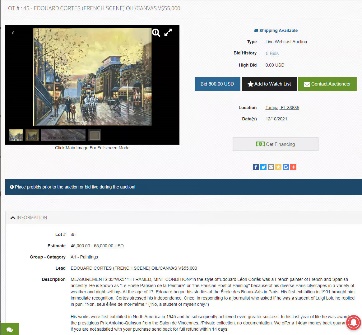
Screen Shot
Works appear in hundreds of sales each month, and there is very little control over what is offered. Many of these salerooms have little regard for the quality, condition, and, most importantly, the authenticity of the works. Their stance is Caveat Emptor – let the buyer beware.
We try to follow as many sales as possible, and I can assure you that is no easy task. Very often, one sale is taking place while another is going on. Online bidding platforms can be challenging to navigate. Sometimes, they crash while people are bidding (which is bad for the seller) or postponed due to outages. There are even sales where all the lots close simultaneously. So, if you were interested in purchasing several works at one of those sales, how can you watch all the lots simultaneously? Not easily. Again, the seller is the one who suffers.
Now, let’s get back to the lack of caring about authenticity that some of the auction rooms seem to have. Earlier this month, we were scrolling through one of the online platforms and came across a painting with the heading – Edouard Cortes (French Scene) Oil/Canvas V$55,000 (image featured here). Just a glance at the photo was all we needed to know that this is not a painting by Edouard Cortes (1882-1969). What was more amusing is that the work carried an estimate of $45,000-$55,000, and when you read the description, squashed between MINT CONDITION and Edouard Léon Cortès are the words “in the style of.” So, the header conveniently omitted the phrase “In the style of,” and the high estimate might make someone think this is the real deal. After the sale, I checked the results, and the painting did sell for a whopping $375!

Fake Cortes
Ok, so now someone has a decorative painting on their wall. However, an unsuspecting individual could have ended up buying this work for a lot of money, thinking they were getting the real thing. Thankfully, that did not happen, but I wonder if the buyer assumes they got the bargain of a lifetime? If you happen to be reading this, I am sorry to burst your bubble.
All auction rooms must be held to a higher standard. When offering a work of art, they should be required to seek advice from true experts so that fakes are not being bought and sold. And one more thing, when you read the terms and conditions of a specific sale, you often see that all property will be sold “AS IS” and there are no guarantees to the correctness of the catalog or the authenticity or description of the items. Always keep the phrase Caveat Emptor in mind when looking at an auction.
My favorite phrase really resonates here – The art world is a jungle, so find the right guide before you become someone’s next meal! Happy hunting!!
Why Does Our Legal System Allow This?
(from 2019)

Legal document header
A few months ago we received an email from a writer at ArtNet asking if we wanted to comment on a lawsuit that was filed claiming our website (and those of over 100 other dealers) was not ADA complaint. What? Whoever heard that a website had to be ADA compliant? Not us, and no one we spoke with in our industry.
What happened next?
First, we contacted our insurance broker to see if we had coverage and received the following reply:
We have received several of these emails from several other galleries and have forwarded a request for coverage analysis to Chubb Group, the insurer for your General Liability Insurance. They are reviewing this suit per the attached confirmation, but we do not believe there is any coverage for this as this policy is designed to provide bodily injury/property damage
.
Traditionally there may be limited coverage under an Employment Practices Liability policy for legal expenses only, which would be subject to the policy deductible. We have offered this coverage in the past, however, it was not purchased. Additionally, we believe the resolution of this complaint will most likely fall under a standard policy deductible, and no insurance payment would be made anyway.
There are opportunities to join other art galleries facing the same complaint and prepare a joint response, thus reducing costs.
After that, I knew this was going to cost us a chunk of change!
Then we called our webmaster, Frank Imburgio, to discuss the matter. Frank had recently dealt with the ADA matter for another client, in a different industry, who was hit with a similar suit. Within a month, our website was brought up to “code.” Now, the worst part of all this is that there are no specific guidelines, from our government, as to what makes a website compliant! Because of that, every industry is now a target for these lawsuits.
As I am sure you can guess, our next step was to hire an attorney and start the legal process. Initially, we spoke with Judith Wallace (Carter Ledyard & Milburn LLP), Douglas Rowe (Certilman Balin Adler & Hyman, LLP), and Joseph DiPalma (Jackson Lewis P.C.). All three gave us great advice and could have easily handled the case; however, in the end, we decided to hire DiPalma since he was already representing about 20 galleries and had past dealings with the plaintiff’s lawyers (the idea was power in numbers). All three attorneys explained that these cases are brought by a select group of attorneys who are just looking to ‘make money’. They know that the cost to defend a case can run into the six figures (yes, over $100,000), so people settle. What I found most interesting, is that the plaintiff is only entitled $500 for each action, while the attorney gets their fees (or the balance of the money received) … and depending on the industry, settlements have run $10,000, $15,000, $25,000 and more. Now multiply any of those numbers by 100 … SICK!
While I was dealing with this, Lance started doing a little research and came across a study by the Lawsuit Reform Alliance of New York released last year titled “Serial Plaintiffs: The Abuse of Title III” — something I recommend everyone read.
Here is my question — When will our government enact laws to prevent this abuse? Oh wait, I just did a Google search and discovered that – According to the Congressional Research Service 170 members of the House and 60 Senators are lawyers. Out of a total of 435 U.S. Representatives and 100 Senators (535 total in Congress), lawyers comprise the biggest voting block of one type, making up 43% of Congress. Sixty percent of the U.S. Senate is lawyers. Guess they are in no rush!
The Rehs Family
© Rehs Galleries, Inc., New York – September 2024
